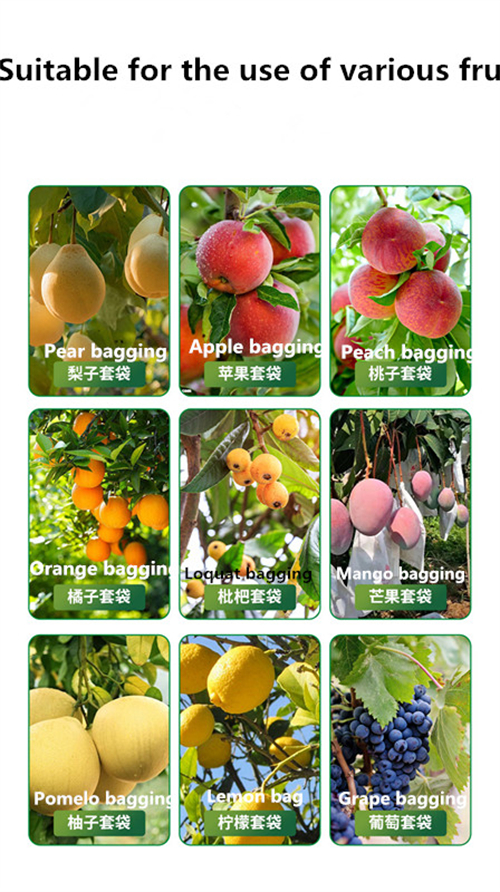Jul . 11, 2024 08:27 Back to list
Fruit bagging improved techniques for mango exporters to boost market competitiveness
Fruit bagging is a common practice among mango exporters to improve the quality and appearance of their fruits. This process involves the placement of bags around individual mangoes while they are still on the tree. The bags serve as a protective barrier, shielding the fruit from pests, diseases, and harsh weather conditions.
One of the main advantages of fruit bagging is that it helps to reduce the need for chemical pesticides. By creating a physical barrier between the mango and potential pests, farmers can minimize the risk of infestation without resorting to harmful chemicals. This is not only better for the environment but also for the health of consumers who will eventually eat the fruit.
In addition to pest control, fruit bagging also has a positive impact on the appearance of the mangoes. The bags prevent blemishes, scars, and other imperfections that can occur during the growth process. As a result, the mangoes that are harvested are more visually appealing and have a higher market value. This can lead to increased profits for mango exporters who are able to sell their fruits at a premium price.
Furthermore, fruit bagging can also help to extend the shelf life of mangoes

fruit bagging in mango exporter. By protecting the fruit from external damage, the bags help to preserve the freshness and quality of the mangoes for a longer period of time. This is particularly important for exporters who may need to transport their fruits over long distances before reaching their final destination. With fruit bagging, mango exporters can ensure that their products arrive in optimal condition, ready to be enjoyed by consumers. Despite its many benefits, fruit bagging does require a significant amount of labor and attention to detail. Each mango must be individually bagged, which can be a time-consuming process. In addition, the bags need to be regularly checked and replaced to ensure that they are still providing adequate protection. However, for many mango exporters, the investment of time and resources in fruit bagging is well worth it for the improved quality and marketability of their products. In conclusion, fruit bagging is an important practice for mango exporters looking to enhance the quality and appearance of their fruits. By protecting mangoes from pests, diseases, and damage, fruit bagging can help to reduce the need for chemical pesticides, improve the visual appeal of the fruit, and extend its shelf life. While it may require additional effort, the benefits of fruit bagging far outweigh the costs for mango exporters who are committed to delivering high-quality products to consumers around the world.

fruit bagging in mango exporter. By protecting the fruit from external damage, the bags help to preserve the freshness and quality of the mangoes for a longer period of time. This is particularly important for exporters who may need to transport their fruits over long distances before reaching their final destination. With fruit bagging, mango exporters can ensure that their products arrive in optimal condition, ready to be enjoyed by consumers. Despite its many benefits, fruit bagging does require a significant amount of labor and attention to detail. Each mango must be individually bagged, which can be a time-consuming process. In addition, the bags need to be regularly checked and replaced to ensure that they are still providing adequate protection. However, for many mango exporters, the investment of time and resources in fruit bagging is well worth it for the improved quality and marketability of their products. In conclusion, fruit bagging is an important practice for mango exporters looking to enhance the quality and appearance of their fruits. By protecting mangoes from pests, diseases, and damage, fruit bagging can help to reduce the need for chemical pesticides, improve the visual appeal of the fruit, and extend its shelf life. While it may require additional effort, the benefits of fruit bagging far outweigh the costs for mango exporters who are committed to delivering high-quality products to consumers around the world.
Latest news
-
Artificial Pollination Solutions for All Plant Pollen Types
NewsJul.29,2025
-
Premium Plant Pollen for Pure Pollination & Pollen Block Solutions
NewsJul.29,2025
-
Artificial Pollination Solutions for Efficient Crop Yields
NewsJul.28,2025
-
Premium Cherry Pollen for Pure Pollination & Different Types of Pollen
NewsJul.28,2025
-
Eco-friendly Fruit Paper Bags with Pollen Block Technology
NewsJul.26,2025
-
Premium Kiwi Pollen for Sale – Fresh Male Kiwi Pollen Supplier
NewsJul.25,2025